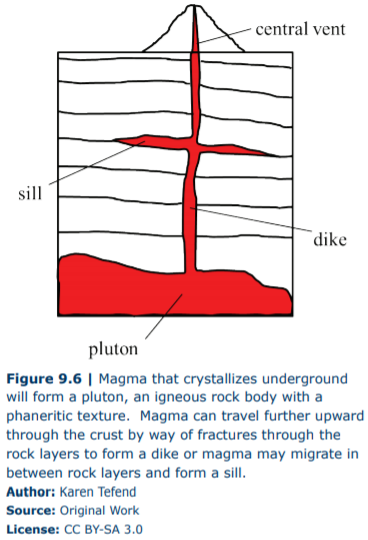9.4: Magmatic Processes Occurring Within The Earth's Crust
- Page ID
- 5622
Overview
Once magma is generated by one of the mechanisms mentioned earlier (increased temperature, decreased pressure, or by adding water), the magma rises upward through the surrounding rock mainly through pre-existing fractures in the brittle lithosphere. A lot of magma stops rising upward through the continental crust because it has encountered an area in the crust that has the same density as the magma. This is a natural occurrence when matter is under the influence of gravity: denser materials will sink whereas lower density materials will rise upward (think of a lava lamp containing two liquids of different densities). This magma will cool slowly underground, and crystallize completely into an igneous rock body called a pluton (Figure 9.6). A lot of these plutonic rock bodies are found along our western coast of North America and other areas where magma must move upward through the thick crust. Some of this magma may reach the surface either through a fissure or through a central vent in a volcanic structure; as the majority of magma stays underground and crystallizes into plutons, the smaller amount of magma that continues upward towards the surface may eventually crystallize completely within these fissures and become a dike or sill (Figure 9.6). Dikes and sills can be found on the surface of the earth due to uplift and erosion of the surrounding rock layers; sills will be oriented parallel to the surrounding rock layers, but dikes cut across them and are therefore easy to identify on the Earth’s surface.

Recall that magma is generated by partial melting of a source rock and if we refer back to Bowen’s Reaction Series (Igneous Rock chapter, or Figure 9.7 in this chapter), we see that minerals have different melting temperatures. If a rock undergoes partial melting, the minerals that melt are those minerals on the bottom of the Reaction Series that are rich in silica (SiO2 ) but poor in iron and magnesium. This means that magma generated by partial melting will be richer in silica and contain less iron and magnesium than the source rock (the rock that partially melted). The different magma types (and the solid rock forms that they make) in Figure 9.7 are listed in order of decreasing iron/magnesium and increasing silica, with ultramafic rocks as the most iron/magnesium-rich and silica poor while the felsic rocks as the most deficient in iron and magnesium but containing the most silica. Therefore, partial melting of a mantle rock, which has an ultramafic composition, will produce a mafic magma. Likewise, partial melting of a mafic rock can produce an intermediate magma type and partial melting of an intermediate rock can produce felsic magma.
There are other ways that felsic and intermediate magmas are produced; for example, magma that is moving upward (ascending) through the crust may melt some of those crustal rocks, which can change the magma’s composition. Recall that the continental crust is the lowest density rock type of the earth, of granitic composition, and is quite thick at convergent plate boundaries (see arrow “d” in Figure 9.5); at convergent plate boundaries, magma may have to travel through this thick portion of the continental crust. At any time before the magma is completely crystallized, it can melt the surrounding crust and perhaps end up with a more silica-rich composition, therefore an intermediate or even a mafic magma will become more felsic as it travels through the continental crust. Whereas most magma crystallizes below ground, a portion of it does erupt onto the surface of the earth, either as a passive lava flow or under more explosive conditions such as the May 1980 eruption of Mount St. Helens, WA. Whether the style of eruption is passive or active (explosive) depends on the magma composition.


